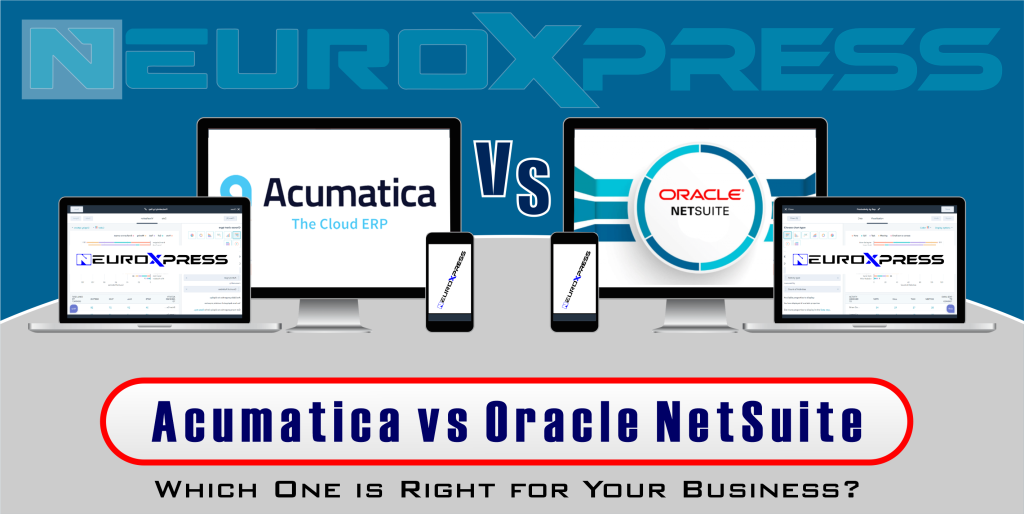Acumatica Cloud ERP vs Oracle NetSuite: Which Cloud ERP Fits Your Business?

Introduction: The ERP Dilemma for a Scaling Business
In 2022, Natalie—CFO of a rapidly growing SaaS company in Austin—found herself at a critical point. Their QuickBooks system had hit its limits, reporting delays were costing deals, and financial audits became a nightmare. Her mission: find a scalable cloud ERP system. After countless vendor calls and demo meetings, the top contenders left standing were Acumatica Cloud ERP vs Oracle NetSuite.
This is a story countless companies live today—especially mid-sized businesses that are scaling fast. Both Acumatica and NetSuite promise cloud-first architecture, integrated systems, and real-time visibility. But which one truly fits your business needs?
This guide delivers a full-scale, objective comparison of Acumatica Cloud ERP vs Oracle NetSuite—so you can choose wisely.
What is Acumatica Cloud ERP?
Acumatica is a modern ERP system built from the ground up for the cloud. It’s designed for growing small to mid-sized businesses across industries—particularly manufacturing, construction, distribution, and services. With flexible licensing and a modern UI, it’s become a favorite for companies that want freedom and control.
Key Highlights:
- True cloud-native architecture
- Resource-based pricing (not per user)
- Open APIs and easy customization
- Real-time dashboards and mobile support
What is Oracle NetSuite?
Oracle NetSuite is one of the pioneers of cloud ERP, with decades of evolution behind it. As a product of Oracle, NetSuite brings enterprise-grade functionality packaged for mid-sized businesses, fast-growing startups, and even global operations.
Key Highlights:
- Over 34,000 customers worldwide
- Fully integrated suite: ERP, CRM, eCommerce, HR
- Role-based dashboards & automation
- Built-in compliance, tax, and localization support
Acumatica Cloud ERP vs Oracle NetSuite: Feature Comparison Table
| Feature | Acumatica Cloud ERP | Oracle NetSuite |
|---|---|---|
| Deployment | Cloud, On-premise, Hybrid | Cloud-only |
| Pricing Model | Resource-based | User-based, module-based |
| Target Business Size | SMBs to Upper Mid-Market | SMBs to Enterprise |
| Interface & Usability | Modern, intuitive | Clean but complex |
| Customization & Extensibility | High, open APIs | High, with SuiteScript & SuiteFlow |
| Integration Capabilities | REST, SOAP APIs, native tools | Extensive, robust partner apps |
| Financial Management | Strong core + industry extensions | Deep accounting & compliance tools |
| Reporting & BI | Real-time dashboards, Power BI | SuiteAnalytics, real-time reports |
| Mobile Access | Full mobile UI | Mobile app available |
| Support & Community | Growing VAR network | Massive global partner ecosystem |
Storytelling: From Growth to Control
A tech startup in Denver switched from Xero to Acumatica in just 90 days and gained instant visibility into cash flow and project costs. Their operations team reported a 60% reduction in manual data entry.
Meanwhile, a mid-sized import/export business chose NetSuite to centralize their global operations. Despite a steep learning curve and longer onboarding, they saw massive improvements in inventory control and tax compliance across five countries.
Both solutions deliver. But each caters to different needs and growth curves.
Pros and Cons Comparison Table
| Criteria | Acumatica Cloud ERP | Oracle NetSuite |
|---|---|---|
| ✅ Pros | ||
| Flexible licensing model | All-in-one platform (ERP + CRM + more) | |
| Lower total cost for growing teams | Enterprise-grade features | |
| High customizability | Extensive partner ecosystem | |
| Faster implementation (avg. 3–6 months) | Scales with complex organizations | |
| Transparent pricing | Global compliance tools | |
| ❌ Cons | ||
| Fewer out-of-the-box modules | High implementation costs | |
| Smaller partner network | User-based pricing gets expensive | |
| Not as strong in enterprise complexity | Long deployment time (avg. 6–12+ months) |
Ideal Use Cases
Acumatica Cloud ERP:
- SMBs or upper mid-market companies
- Industries like manufacturing, construction, or retail
- Businesses seeking full ownership & API control
- Cost-conscious companies needing flexibility
Oracle NetSuite:
- High-growth businesses with global needs
- Companies needing strong financial compliance
- Enterprises with multiple business units
- Organizations looking for one ERP-CRM-eCommerce suite
Licensing & Implementation
- Acumatica uses a usage-based pricing model. You pay based on computing power, not number of users.
- NetSuite uses user + module pricing. Each additional feature increases costs, which can add up fast.
Average Implementation Time:
- Acumatica: 3 to 6 months
- NetSuite: 6 to 12+ months
Integration & Scalability
Both systems excel in integrations but in different ways:
- Acumatica is developer-friendly, offering RESTful APIs and Web Services.
- NetSuite offers built-in workflows and thousands of SuiteApps in its marketplace.
Summary Diagram Table of Acumatica Cloud ERP vs Oracle NetSuite
| Category | Winner |
|---|---|
| Affordability | Acumatica |
| All-in-One Platform | NetSuite |
| Customization | Tie |
| Deployment Speed | Acumatica |
| Global Compliance | NetSuite |
| Reporting & Analytics | NetSuite |
| Developer Friendliness | Acumatica |
| Community & Support | NetSuite |
Final Verdict: Acumatica Cloud ERP vs Oracle NetSuite
If you’re a growing SMB looking for affordable ERP with full customization, Acumatica Cloud ERP offers flexibility and control—especially if you’re tech-savvy.
But if your business spans multiple entities, countries, or product lines, Oracle NetSuite’s integrated suite and enterprise-class tools will pay off in the long term.
The best ERP isn’t always the biggest—it’s the one that fits your growth stage, your budget, and your internal capabilities.
External Resources